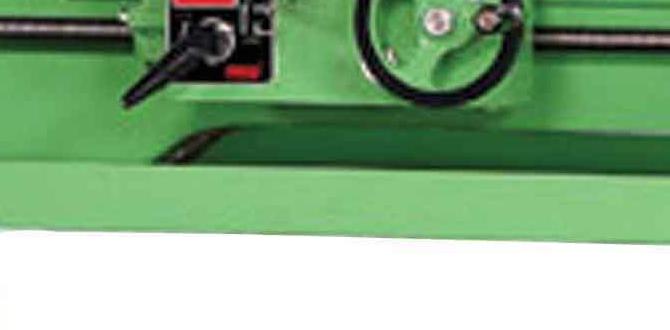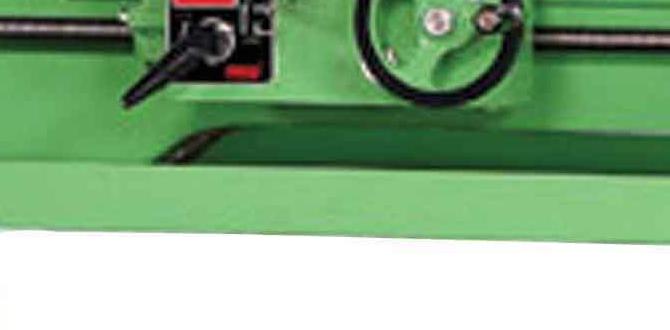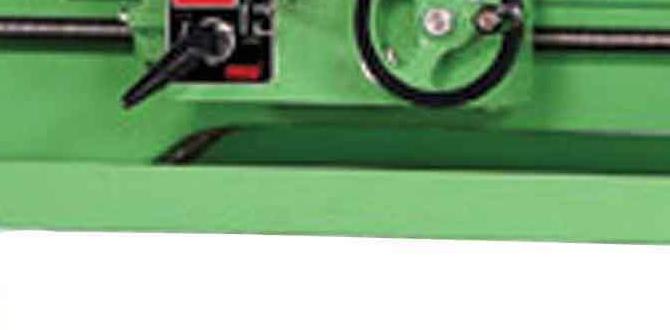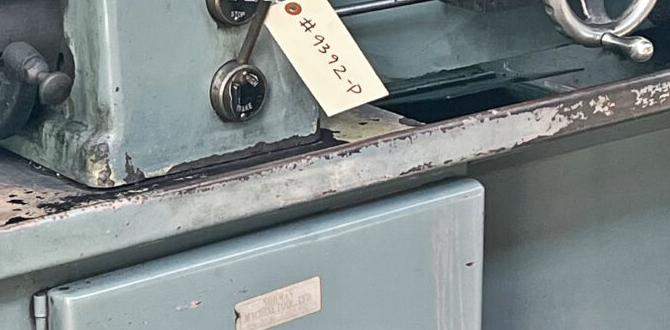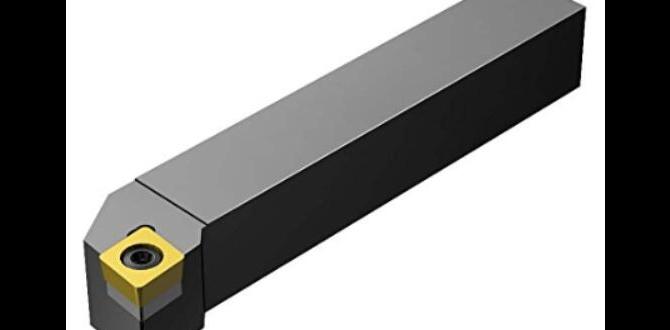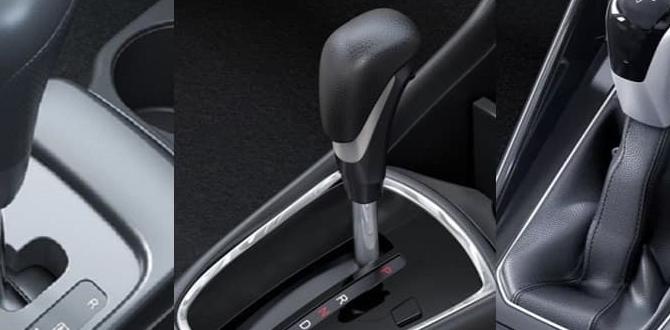A wood lathe with a reverse gear offers significantly more control and versatility for shaping wood. This feature is essential for advanced techniques like tenoning, faceplate work, and achieving a smoother finish, making it a crucial consideration for any serious woodworker.
Hey there, fellow makers! Daniel Bates here from Lathe Hub. Ever stand at a woodworking store, staring at two wood lathes, one with a reverse gear and one without, and wonder if that extra feature is really worth the bucks? It can be confusing for beginners, right? You want to get started on those amazing projects, but every detail matters. Don’t stress! Choosing the right lathe is a big step, but it doesn’t have to be overwhelming. We’re going to break down exactly why a reverse gear is such a game-changer and help you make the best choice for your workshop. Get ready to unlock some new creative possibilities!
Why a Reverse Gear on Your Wood Lathe Matters
As you dive deeper into woodworking, you’ll find that certain tasks become much easier, safer, and more precise with specialized features. The reverse gear on a wood lathe is one of those game-changing additions. While many entry-level lathes operate with the workpiece spinning in just one direction, adding the ability to reverse that direction opens up a world of possibilities for both efficient material removal and achieving a superior finish. Think of it like having a tool that can do more than just one job exceptionally well; it expands your capabilities and can even save you time and frustration in the long run.
Understanding How a Wood Lathe Works (The Basics)
Before we get into the specifics of reverse gear, let’s quickly recap how a basic wood lathe functions. A wood lathe is a stationary tool that spins a piece of wood. You then use sharp cutting tools, like chisels and gouges, to shape the spinning wood. The motor turns the headstock, which holds the workpiece via a drive center. The tailstock supports the other end of the wood. You move your tools along the tool rest to carve and shape the material. This fundamental spinning action is what allows for the creation of round, symmetrical objects like bowls, spindles, and table legs.
Now, imagine that spin. It’s always going in one direction. This works fine for many basic turning operations. However, certain types of cuts and finishing techniques can be significantly enhanced when you can flip that direction. That’s where the magic of the reverse gear comes in.
What Exactly is a Reverse Gear?
A reverse gear on a wood lathe is a mechanism that allows you to change the direction of the spindle’s rotation. Instead of the wood spinning only counter-clockwise (as is typical for most lathes), you can engage the reverse gear to make it spin clockwise. This isn’t just a simple button push; it usually involves a lever or a switch that engages a set of gears within the lathe’s system to physically reverse the direction of the drive belt or motor connection to the spindle.
This feature is often found on more advanced or professional-grade lathes, but its availability on some mid-range models means more hobbyists and aspiring woodturners can access its benefits without breaking the bank. The ability to switch between forward and reverse rotation is what differentiates a standard lathe from a more versatile one.
The Key Benefits of a Reverse Gear
So, why go through the trouble of adding this feature? The advantages are significant, affecting the quality of your work, the ease of your process, and even your safety. Let’s break down the most compelling reasons why a wood lathe with a reverse gear option is a wise investment.
1. Superior Surface Finish
One of the most celebrated benefits of a reverse gear is its impact on achieving a incredibly smooth surface finish. When you are sanding a piece, especially on the end grain of a bowl or the face of a platter, sanding with the lathe spinning in the “normal” (usually counter-clockwise) direction can sometimes catch the grain and lead to tear-out or a slightly fuzzy surface. By reversing the direction and sanding against the grain in this specific way, you can often achieve a much cleaner, smoother finish with less effort.
Think of it like brushing your teeth. If you only brush in one direction, you might miss spots or not get a truly deep clean. Reversing the motion can help you reach those tricky areas and ensure a more thorough and polished result. For turners aiming for gallery-quality finishes, this capability alone can be a deciding factor.
2. Easier and Safer Tenoning
Tenons are short, cylindrical projections on the end of a workpiece, often used for mounting pieces to faceplates or for joining parts together. When you’re turning a tenon, the cutting tool moves across the grain. If the lathe is spinning too fast or the cut is too aggressive, the tool can catch the wood, leading to a dangerous “chatter” or even the workpiece being thrown from the lathe. This is particularly true when turning pieces that are not perfectly balanced or when working with tougher woods.
With a reverse gear, you can often turn tenons more gracefully and with greater control. By engaging reverse, you can approach the tenon from a different angle, which can help the cutting tool “climb” the grain slightly in a more controlled manner, rather than digging in abruptly. This makes the process smoother and significantly reduces the risk of kickback, enhancing user safety. Many experienced turners find themselves using reverse specifically for this operation.
3. Efficient Faceplate Work
Faceplate work involves mounting larger, flatter items like bowls or platters securely to a faceplate attached to the lathe’s spindle. When you’re hollowing out a bowl, for example, you’re working from the center outwards on a rotating surface. If your lathe has a reverse gear, you can reverse the direction of rotation to make sanding the inside of the bowl much easier and more effective. You can also use the reverse function to aid in chucking and some initial shaping operations when working with bowls and other large faceplate items.
This is particularly helpful when you’re trying to get a perfectly flat and smooth surface for the bottom of a bowl or for a picture frame. Reversing the direction can help you achieve a more uniform sanding pattern and avoid those frustrating circular marks that are hard to remove.
4. Improved Control on Specific Cuts
Beyond tenons and faceplate work, there are numerous other cutting situations where reverse gear offers enhanced control. For instance, when you’re working with very soft woods that tend to chip easily, or when making very fine finishing cuts, a slight change in rotational direction can make a difference to how the tool interacts with the wood. It allows for more delicate scraping and shearing cuts, giving you an extra level of finesse in your turning.
Consider a situation where you’ve achieved a near-perfect shape and just need to make one last, very light pass to clean it up. If the tool tends to snag in forward rotation, switching to reverse might provide the perfect smooth cutting action you need without risking marring the workpiece.
5. Easier Deburring and Finishing
When working with certain types of wood or after using tools like scrapers, you might end up with small burrs or rough edges. In the forward direction, these can be tough to catch cleanly. Using the reverse gear can allow you to gently scrape or sand these burrs away more effectively, leaving a truly clean edge and a more professional finished product.
This is a subtle but important advantage. It’s these small details that often separate amateur work from pieces that truly impress. The reverse gear gives you another tool in your arsenal to polish those edges to perfection.
Are There Downsides to a Reverse Gear? Not Really for the Beginner.
For a beginner woodturner, the “downsides” are minimal and often outweighed by the benefits. The primary considerations might be cost and complexity, but modern lathes often integrate this feature seamlessly.
- Initial Cost: Lathes equipped with a reverse gear often have a slightly higher price tag than their single-direction counterparts. However, as we’ll discuss, the added versatility can make this a worthwhile investment that saves money in the long run by allowing you to tackle more projects.
- Complexity: While modern reverse gear mechanisms are usually straightforward to operate (often a simple lever), it does add another element to learn. However, for anyone seeking to grow their skills, mastering this simple operation is a quick and rewarding process.
It’s important to note that for absolute beginners just learning to make a basic cylinder or spindle, the reverse gear might not be immediately critical. However, as your aspirations grow beyond simple shapes, its value quickly becomes apparent. The learning curve for using the reverse gear is gentle, and the payoff in terms of capability and finish quality is substantial.
Who Needs a Wood Lathe With Reverse Gear?
While it’s a fantastic feature for almost anyone, certain types of woodturners will find it absolutely indispensable:
- Bowls Turners: Especially those who habitually turn large-diameter bowls where faceplate work is common.
- Spindle Turners Aiming for Fine Finishes: Turners who want the smoothest possible spindles and decorative elements will appreciate the sanding and finishing advantages.
- Hobbyists Who Want Versatility: If you plan to tackle a wide range of projects, from small decorative items to larger functional pieces, the reverse gear provides essential flexibility.
- Students and Apprentices: Learning with a more capable machine provides a broader understanding of turning techniques from the outset.
- Makers Focused on Professional Results: Those who aim for a high-quality, polished finish will find the reverse gear invaluable for those final touches.
Comparing Lathes: Key Features to Look For
When you’re shopping for a wood lathe, especially one with a reverse gear, here are some essential features to consider:
Essential Features for Any Wood Lathe:
- Motor Power: Adequate horsepower for the size of workpieces you intend to turn.
- Swing and Bed Length: The maximum diameter and length of wood you can accommodate.
- Speed Range: A variable speed control is crucial for safety and for different turning operations. Lower speeds are better for roughing and larger pieces, while higher speeds are good for finishing.
- Tool Rest System: A sturdy, easily adjustable tool rest is vital for safe and effective cutting.
Features Enhanced by Reverse Gear:
- Reverse Gear Mechanism: Look for a clearly marked and easy-to-operate lever or switch.
- Headstock Swivel: While not directly related to reverse gear, a swiveling headstock can make bowl turning (where reverse gear is useful) even easier.
- Quality Bearings and Spindle: For smooth operation, especially at varying speeds and directions.
How to Use the Reverse Gear Safely
Safety is always paramount in any workshop. Using a reverse gear is no different. Here are some critical safety tips:
- Always Stop the Lathe: Never engage or disengage the reverse gear while the lathe is spinning at full speed. Always bring the spindle to a complete stop before making the change.
- Know Your Lathe’s Design: Read your lathe’s manual thoroughly to understand how its specific reverse gear mechanism works and any manufacturer recommendations.
- Secure Your Workpiece: Ensure your workpiece is firmly secured to the headstock and tailstock (if used) before starting the lathe, whether in forward or reverse. A loose workpiece is extremely dangerous.
- Use Appropriate Speeds: Just like in forward rotation, slower speeds are generally safer when using the reverse gear, especially for initial cuts, hollowing bowls, or when turning tenons.
- Be Aware of Tool Catching: While reverse gear can reduce snagging, it’s still possible. Maintain a firm grip on your tools and control your cuts.
- Use Push Cuts for Finishing: When sanding or doing fine scraping in reverse, use “push cuts” where the tool’s bevel is presented to the wood and you are gently pushing the tool into the cut rather than pulling.
Understanding Tool Control in Reverse
When using the reverse gear, your tool control might feel slightly different. For example, when using a skew chisel for scraping cuts, you’ll be presenting the tool differently to the wood. For beginners, it’s often recommended to start with very shallow cuts and practice on scrap wood to get a feel for how the tool interacts with the spinning workpiece in the reversed direction. This experimentation is key to mastering the technique safely and effectively.
When is a Reverse Gear Absolutely Essential?
While many tasks can be accomplished without it, there are specific scenarios where a reverse gear moves from being “highly desirable” to “practically essential” for achieving optimal results and safety:
Advanced Bowl Hollowing and Finishing: For bowls with a significant depth, especially those using a jam chuck or faceplate, the ability to reverse the lathe for sanding can dramatically improve the final surface quality by allowing you to sand against the grain in a controlled manner to remove any fuzzies or tear-out left by forward-spinning sanding. This is a pro-level technique that’s hard to replicate otherwise.
Specific Faceplate Operations: When you need to achieve a perfectly flat bottom on a bowl or platter, or when working on items that require mounting to very specific fixtures, the added control offered by reverse can be crucial.
Complex Tenon Turning: While basic tenons can be turned in forward gear, achieving very precise, smooth, and safe tenons for critical joints or chucking can be significantly easier with the controlled approach that reverse rotation allows, particularly for those who prefer a scraping cut technique.
Choosing the Right Lathe: New vs. Used and What to Expect
When it comes to purchasing a wood lathe with a reverse gear, you have options:
New Lathes:
New lathes typically come with warranties and the latest technological advancements. Brands like Grizzly Industrial, JET, and Powermatic often offer models with reverse gear functionality. These machines are built with modern safety standards and user-friendly features.
Used Lathes:
A used lathe can be a fantastic way to get a high-quality machine at a lower price point. However, when buying used, it’s crucial to inspect the machine thoroughly:
- Check the Reverse Mechanism: Ensure it engages smoothly and holds reliably.
- Inspect for Wear: Look for excessive wear on the ways (the bed where the tool rest slides), the headstock, and the tailstock.
- Test the Motor and Speed Control: Listen for unusual noises and ensure the speed changes smoothly through its entire range.
- Check for Damage: Look for any cracks, dents, or signs of abuse.
For a comprehensive guide on buying used woodworking machinery, resources like the Woodworking Talk forum often have excellent discussions and advice from experienced users.
What to Expect Regarding Price:
Lathes with reverse gear functionality will generally be more expensive than basic models. For a new lathe with a reverse gear, you might expect to pay anywhere from $800 to $3000+, depending on the size, power, and brand. Used machines can significantly reduce this cost, but prices can vary widely based on condition and brand.
FAQ: Your Wood Lathe Questions Answered
Here are some common questions beginners have about wood lathes and reverse gears:
Q1: My lathe doesn’t have a reverse gear. Can I still sand smoothly?
A1: Yes, you absolutely can achieve smooth finishes without a reverse gear! It just might require a bit more technique and patience. Using sharp tools like cabinet scrapers and doing your sanding in multiple grits, working up to very fine grits (like 400 or 600), will help. Some woodturners also use a technique called “sanding with the grain in reverse” by carefully pushing the sandpaper into the spinning wood at a very shallow angle to burnish the surface, but it requires practice and is not the same as the machine’s reverse gear.
Q2: Is it safe to turn at high speeds when using the reverse gear?
A2: Generally, it’s advisable to use slower speeds when working with the reverse gear, especially when performing cuts, or any time you’re not sanding. The mechanics can sometimes feel less intuitive in reverse, and slower speeds provide more time to react and maintain control if something feels off. Always refer to your lathe’s manual for specific speed recommendations when using the reverse function.
Q3: What kind of projects benefit most from a reverse gear?
A3: Projects like bowls, platters, and any larger faceplate work are prime candidates. Also, intricate spindle work where achieving a perfect, fuzz-free finish is critical. Tenoning for precise joinery can also be made safer and more accurate.
Q4: How do I know if a used lathe has a functional reverse gear?
A4: When inspecting a used lathe, always ask the seller to demonstrate the reverse gear. Power on the lathe, ensure it stops completely, then engage the reverse lever. The spindle should now rotate in the opposite direction. Test to make sure it doesn’t make grinding noises and engages positively. Inspect the lever and mechanism for obvious damage or wear.
Q5: Will a reverse gear help with all woods?
A5: While it helps across the board, its benefits are often more pronounced

